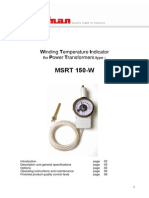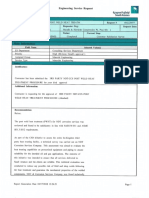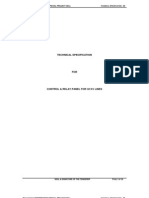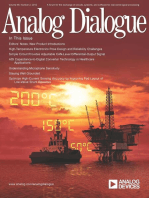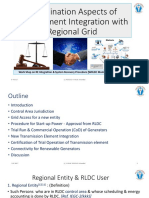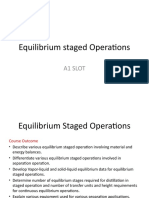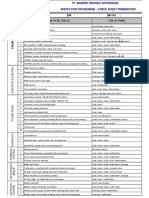Static CT/CVT Operated Trivector Meter
Static CT/CVT Operated Trivector Meter
Uploaded by
lrpatra0 ratings0% found this document useful (0 votes)
37 views8 pagesThe document provides specifications for static CT/PT operated tri-vector meters for low and high voltage supply. It outlines applicable standards, climatic conditions, tropical treatment requirements, electrical specifications including class of accuracy, supply voltage, current, power factor range, and surge protection. It also covers temperature rise, anti-tamper features, construction details, display of measured values including active energy, reactive energy, apparent energy and power factor, maximum demand registration and reset, meter case and cover material options, and terminal block and cover specifications.
Original Description:
Trivector meter tech description
Original Title
chap12
Copyright
© © All Rights Reserved
Available Formats
PDF, TXT or read online from Scribd
Share this document
Did you find this document useful?
Is this content inappropriate?
Report this DocumentThe document provides specifications for static CT/PT operated tri-vector meters for low and high voltage supply. It outlines applicable standards, climatic conditions, tropical treatment requirements, electrical specifications including class of accuracy, supply voltage, current, power factor range, and surge protection. It also covers temperature rise, anti-tamper features, construction details, display of measured values including active energy, reactive energy, apparent energy and power factor, maximum demand registration and reset, meter case and cover material options, and terminal block and cover specifications.
Copyright:
© All Rights Reserved
Available Formats
Download as PDF, TXT or read online from Scribd
Download as pdf or txt
0 ratings0% found this document useful (0 votes)
37 views8 pagesStatic CT/CVT Operated Trivector Meter
Static CT/CVT Operated Trivector Meter
Uploaded by
lrpatraThe document provides specifications for static CT/PT operated tri-vector meters for low and high voltage supply. It outlines applicable standards, climatic conditions, tropical treatment requirements, electrical specifications including class of accuracy, supply voltage, current, power factor range, and surge protection. It also covers temperature rise, anti-tamper features, construction details, display of measured values including active energy, reactive energy, apparent energy and power factor, maximum demand registration and reset, meter case and cover material options, and terminal block and cover specifications.
Copyright:
© All Rights Reserved
Available Formats
Download as PDF, TXT or read online from Scribd
Download as pdf or txt
You are on page 1of 8
STATIC CT/CVT OPERATED TRIVECTOR METER
STATIC CT/CVT OPERATED TRI-VECTOR METERS FOR LT/HT SUPPLY
1. SCOPE
This Specification covers the design, manufacture, testing before despatch, supply and delivery of Static
CT/PT operated Tri-Vector Meters for 3 phase 3 wire and 3 phase 4 wire balanced/unbalanced load for use
in urban/rural areas.
2. APPLICABLE STANDARDS
Unless otherwise expressly modified and to the extent so modified from these specifications, the meters
shall comply with the latest versions of IEC 687 and IS 14697.
Further, meters from ISO certified manufacturers shall be preferred.
3. CLIMATIC CONDITIONS
i) Temperature : -10
o
C to 55
o
C(in shade)
ii) Humidity : up to 95% RH non-condensing
iii) Average annual rainfall : 150 cm.(if not specified otherwise)
iv) Max. Wind Pressure : 150 kg/sq. m.
v) Max. altitude above MSL : 1000 m.(if not specified otherwise)
(To be modified as per site conditions)
4. TROPICAL TREATMENT :
The meters shall be suitably designed and treated for normal life and satisfactory operation under the hot
and hazardous tropical climate conditions and shall be dust and vermin proof. All the parts and surface
which are subject to corrosion shall either be made of such material or shall be provided with such protective
finish which provides suitable protection to them from any injurious effect of excessive humidity
5 ELECTRICAL SPECIFICATIONS
Class of Accuracy Class 1.0/Class 0.5/Class 0.2
Supply Voltage 240 V AC (phase to neutral), 415V AC (phase to phase) or
230V (Phase Neutral) 400 V (Phase to Phase)
PT Secondary 110 V, 110/?3 V
Frequency 50 Hz
Current Ib 1A/5A (for CT operated)
Maximum Current 120% of Ib for CT operated
Starting Current As per IS 13779/IS 14697/IEC 687
Power Factor Range 0.5 lag Unity 0.8 lead
Power Loss As per IS 13779/ IS 14697/CBI&P 88
Resistance to surge voltage
of 1.2/50 Microsec. As per IS 13779/ IS 14697
Test Voltage at 50 Hz for 1 min. 2 kV rms
Clock Time Accuracy +/- 5 ppm at 250 C
6. TEMPERATURE RISE
As per IS 13779/IS 14697
7. ANTI TAMPER FEATURES
The meter shall have the following anti-tamper features:
i) The meter shall not get damaged even if any phase and neutral are interchanged.
ii) The meter should register energy even when the load is not terminated back to the meter and instead
current is drawn through a local earth.
iii) The meter shall be factory calibrated and shall be sealed suitably before despatch.
iv) The meter shall be capable of recording occurrence of missing potential and its restoration with date and
time of all occurrences with the total number of such occurrences during the above period for all the phases.
v) The meter shall detect CT polarity reversal and record the same with date and time of all occurrences and
restorations with total number of such occurrences during the above period for all the phases.
vi) The meter shall work correctly irrespective of the phase sequence of supply.
vii) In case of 3 phase 4 wire system, the meter should keep working even in the presence of any two wires
i.e. even in the absence of neutral and any one phase or any two phases.
viii) In case of three phase three wire meters, even if reference Y phase is removed, the meter shall
continue to work.
8. CONSTRUCTION
The case, winding, terminal disconnecting device for the meter, voltage circuit, sealing arrangement,
registers, terminal block, terminal cover and name plate etc. shall be in accordance with the relevant
Standard. The meter shall be compact and reliable in design, easy to transport and immune to vibration and
shock involved in transportation and handling. The construction of the meter shall ensure consistent
performance under all conditions specially during dust storm/heavy rains/very hot weather. The insulating
material used in the meter should be non-hygroscopic, non-aging and of tested quality. The meter should be
sealed in such a way that the internal parts of the meter are inaccessible.
The meter should employ latest technology such as Hybrid Micro Circuit or Application Specific Integrating
circuit (ASIC) to ensure reliable performance. The mounting of components on the PCB (Printed Circuit
Board) shall preferably be SMT(Surface Mounted Technology ) type. The electronic components used in the
meter shall be of high quality and there shall be no drift in the accuracy of the meter at least up to 10 years.
The circuitry in the meter shall be compatible with 2x8 bit, 16 bit (or better) processor and the meter shall be
based on digital measuring and sampling technique.
9. DISPLAY OF MEASURED VALUES
The meter shall have alpha-numeric LCD display with at least 6 full digits and preferably one
decimal(optional) along with legend and the data shall not be lost in the event of power failure. The non-
volatile memory shall have a storage life (without use) of at least 10 years.
The meter shall be capable of measuring and displaying the following electrical quantities within specified
limits of accuracy:
i. Active Energy
ii. Reactive Energy
iii. Apparent Energy
iv. Power Factor
v. Maximum Demand
vi. MD reset count
Meter shall carry out periodic self check on performance of electronic circuits, memory, crystal oscillator etc.
and should indicate any abnormal condition with suitable error message.
The meter shall give error message on display in case tampering occurs or meter malfunctions.
The meter shall have facility on display itself to pick up pulses to facilitate testing with reference
STANDARD.
10. MAXIMUM DEMAND REGISTRATION AND RESET
The meter shall continuously monitor and calculate the average maximum demand for each interval of time
and this interval shall be factory programmable i.e. hour, half hour or one hour.
The MD shall automatically reset at 00.00 Hrs. on the first date of each calendar month. The meter shall
have a provision of manual resetting of Maximum Demand with proper sealing facility. Provision for auto-
resetting of MD at fixed date and time shall also be possible.
11. METER CASE AND COVER
The meter shall have a case which can be sealed in such a way that the internal parts of the meter are
accessible only after breaking the seal. The cover shall not be easily removable from the base. The material
of meter body (case and cover) shall be either
(A) THERMOSETTING PLASTIC
Self insulating non corroding black thermosetting material which would ensure maximum strength against
distortion and also injury to working parts during normal use and rough handling during transportation. The
material shall not soften/ melt on heating.
(B) ENGINEERING PLASTIC
The meter casing material should be glass reinforced, flame retardant, unbreakable engineering plastic
material to ensure high reliability, long trouble free life, safety against electric shock, spread of fire and
effects of excessive temperature. The material should be corrosion resistant, inert to chemicals, oxidising
agents, petro-chemical products, acids, salts, and ultraviolet radiation. The meter chamber shall be dust
proof and moisture proof. The supplier should indicate hardness, melting temperature and tensile yield
strength of the material and necessary test certificate of the same shall be furnished. The meter case and
cover should be sturdy enough to prevent damage during transportation and installation.
The engineering plastic housing may be provided with a key hole on the top for fixing which should not be
accessible to the consumer after the terminal cover is sealed. The meter shall withstand external magnetic
influence as per latest amendments of CBIP Technical Report No. 88.
The engineering plastic used shall conform to IS 11731 besides meeting the test requirement of heat
deflection test as per ISO 75 and glow wire test as per relevant Standard.
(C) STEEL BODY
The meter casing shall be made of sheet steel of at least 22 gauge(0.71 mm) thickness with 4 screws for
fixing frame with lock and tempered spring washer. Synthetic rubber or any other non-hygroscopic material
should be used for gasket and for fixing the meter cover over the body. The tenderer shall specify the
thickness of sheet steel used for the construction of the meter cover, base and the material of the gasket in
the guaranteed technical particulars.
The window shall be dust proof made of toughened glass and be provided to permit clear view of register
and indicator. Minimum clearance between window glass and name plate should be 8mm. Fixing
arrangement should be such that the window glass can not be removed without breaking the sleeves of the
window glass and shall be replaceable from inside only.
12. TERMINAL BLOCK AND COVER
The terminals may be grouped in a terminal block having adequate insulating properties and mechanical
strength. The terminal block should be made from best quality non-hygroscopic, flame retardant material
(capable of passing the flammability tests given in IS 11731) with nickel plated brass or aluminium alloy for
connecting terminals.. The terminal block is to be enclosed in a metallic housing of steel plate of sufficient
thickness to cover its back and sides to provide enough strength for purpose of tightening of screws. The
clamping screw should be provided inside the terminal cover and should have metallic sleeve moulded
within the block to avoid damage during tightening of the screws.
The terminals in the terminal block shall be of adequate length in order to have proper grip of conductor with
the help of two screws. The screws shall have thread size not less than M4 and head having 4-6 mm. dia.
The screws shall not have pointed ends at the end of threads. All terminals and connecting screws and
washers should be of tinned / nickel plated brass material or aluminium alloy.
The internal diameter of terminal hole should be minimum 5.5 mm. The holes in the insulating material shall
be of sufficient size to accommodate the insulation of conductor also.
The terminal cover shall be of sheet steel with minimum thickness 0.6 mm. or Engineering plastic with
minimum thickness 2.5 mm. and the terminal cover shall be of extended type completely covering the
terminal block and fixing holes except for the provision of conductor entry at the bottom for incoming and
outgoing leads. The terminal cover shall be so provided that it remains permanently connected with meter
base. The supplier shall suitably design the cover so that it opens or closes like a hinged door and the ends
of hinged pins shall be flattened so that it does not come out.
In order to facilitate testing of meters without opening the meter cover the voltage links shall also be
provided preferably on front side above the terminal block so that the same is accessible from outside
without opening the meter body cover or seal. Separate sealing arrangement should be available for these
links.
13. NAME PLATE AND MARKING:
Every meter shall have a name plate clearly visible and indelible and distinctly marked in accordance with
the relevant Standard. The following information should appear on an external plate attached to the meter
cover:
i. Manufacturers name or trade-mark and place of manufacture
ii. Designation of type
iii. Number of phases and number of wires for which the meter is suitable.
In addition to above, the following information shall be marked on a nameplate preferably placed
within the meter:
a. Serial number and year of manufacture
b. Principal unit in which the meter records
c. Reference voltage
d. Basic current and rated maximum current
e. Reference frequency in Hz
f. Meter constant
g. Class index
h. Reference Temperature
14. INFLUENCE QUANTITIES :
The meter shall work satisfactory with guaranteed accuracy as per limit of relevant IS under presence of the
following quantities :
i. External magnetic field
ii. Electromagnetic field
iii. Radio frequency interference
iv. Vibration
v. Harmonic wave form
vi. Voltage fluctuation
vii. Electromagnetic high frequency field
15. LED INDICATIONS
There shall be a visual signal to indicate the operation of the meter.
16. POWER CONSUMPTION BY METER
As per IS 13779/ IS 14697.
17. CURRENT & VOLTAGE CIRCUITS
The current & voltage circuits shall be made of appropriate material such as enameled copper wire of EC
grade. The current circuit shall be appropriately insulated and the potential circuit appropriately
encapsulated . The cross section of current carrying wires shall be designed so as to withstand the
temperature rise of 50
o
C over the ambient temperature at maximum current. The maximum current density
shall not exceed 620 amp per sq cm. at maximum current for conductors to be used in current coil. The
short time current rating shall be as per IS 13779.
Apart from the link provided in voltage circuit within the terminal block, it shall be possible to disconnect
easily the voltage terminal from the input current terminal within the main body of the meter. The
disconnecting device shall be such that it is easy to de-link them. It shall be made of brass (tinned) of
minimum thickness 0.7 mm. In de-linked position, the link should not come in contact with any live part or
body of the meter. While supplying the meters the links must be in closed position.
18. STARTING CURRENT
As per IS 13779/ IS 14697.
19. FIXING ARRANGEMENT
Every meter shall have three fixing holes one at the top and two at the bottom. The top hole shall be
provided with a special clip at the back of the meter so that holding screw is not accessible to the consumer
after the fixing of the meters. The lower fixing screws shall be provided under the sealed terminal cover. The
requisite fixing screws shall be supplied with each meter.
20. SEALING ARRANGEMENT
At least, two sealing screws shall be provided for proper fixing of the meter cover so that access to the
working part shall not be possible without breaking the seal. Necessary provision may be kept for fixing the
utility seal also.
21. OUTPUT DEVICE
The meter shall have a test output device in the form of a pulse indicator accessible from the front and
capable of being monitored by a suitable testing equipment.
22. COMMUNICATION CAPABILITY
The meter shall have ports suitable for interface of the meter with appropriate protocol to
i. Meter Reading Instrument (MRI)
ii. Stand alone computer (for eg. desk top computer/PC/laptop)
iii. Facilitate reading or reprogramming by the utility from remote locations
Calibration of meter should not be possible through the meter reading instrument to avoid meter tampering
through MRI.
23. RUNNING AT NO LOAD
The meter should comply with the requirements of the relevant Standard.
24. D.C. IMMUNITY TEST
The meter should comply with the requirements of the relevant Standard.
25. PACKING
The meters shall be suitably packed for vertical/horizontal transport to withstand handling during transport.
The Bidder shall be responsible for any damage during transit due to inadequate or improper packing.
26. ACCURACY
The accuracy of meters shall not exceed the permissible limits of accuracy as per Standards for a period of
10 years from the date of supply. In case any drift is noticed which is beyond the permissible limits, the
Bidder shall re-calibrate the meter for correct accuracy and if re-calibration is not possible, the meter shall be
replaced by a new meter without any extra cost.
27. TESTS
TYPE TESTS:
Meters shall be fully type tested as per the relevant Standard(latest version). The type test certificates shall
be submitted along with the offer. Offer without Type Test Report shall be liable for rejection. The Type Test
Certificate shall not be more than 5 years old. Test certificates of wider Ranges shall also be acceptable.
The Acceptance and Routine Tests shall be carried out as per the latest version of the relevant standard. In
addition to above, the following tests shall also be performed:
i) Transportation Test(Acceptance Test)
At least 50% of the sample meters shall be particularly tested for error at Imax., Ib at u.p.f. and 50% Imax.,
10%Ib at 0.5 p.f. lag besides checking them for starting current and creep. The meters should be tested as
aforesaid with the meter cover fully tightened and sealed. After recording the errors at the above test points,
the meters should be placed in their normal packing and transported for a distance of at least 40 to 50 kms.
in any transport vehicle such as a truck, jeep etc. on uneven rural roads, and then re-tested at the aforesaid
test points after transportation. The variation in errors recorded before and after the transportation test at the
said test points should not exceed 1% at higher loads and 1.5% at low loads.
The mechanical strength of the meter shall be tested with spring hammer as per the relevant Standard.
TEST CERTIFICATES:
The type test certificates shall be from Institutions approved by the purchaser/ As per Appendix G of CBIP
Technical Report 88(Amended).
28. Guarantee:
The meter shall have a design life of at least 10 years and be guaranteed for a period of at least 5 years
against manufacturing/design defect. The meter found defective within the above guarantee period shall be
replaced/repaired by the supplier free of cost within one month of the receipt of intimation. If the defective
meters are not replaced/repaired within the above specified period, the purchaser shall recover an
equivalent amount plus 15% supervision charges.
29. QUALITY ASSURANCE PLAN:
The design life of the meter shall be minimum 10 years and to prove the design life the firm shall have at
least the following Quality Assurance Plan:
i. The factory shall be completely dust proof .
ii. The testing rooms shall be temperature and humidity controlled as per relevant Standards.
iii. The testing and calibrating equipment should be automatic and all test equipment shall have their
valid calibration certificates.
iv. Power supplies used in testing equipment shall be distortion free with sinusoidal wave-forms and
maintaining constant voltage current and frequency as per the relevant Standards.
v. During the manufacturing of the meters the following checks shall be carried out.
a. Meter frame dimension tolerance shall be minimum.
b. The pressure coil shall be made totally encapsulated and care shall be taken to avoid
ingress of dust and moisture inside the coil.
c. The assembly of parts shall be done with the help of jigs and fixtures so that human errors
are eliminated.
d. The meters shall be batch tested on automatic, computerised test bench and the results
shall be printed directly without any human errors.
e. The current coil shall be made with the help of jigs and fixtures.
f. The potential coil shall be made with automatic computerised machine.
30. TESTING AND MANUFACTURING FACILITIES
The Bidder shall have at least the following testing facilities to ensure accurate calibration:
i. Insulation resistance measurement
ii. Running at no load
iii. Starting current test
iv. Limits of error
v. Range of adjustment
vi. Power loss in voltage and current circuits
vii. Repeatability of error
viii. Transportation test
ix. Low load run test
x. Heating test
The Bidder shall give a detailed list of bought out items with name of the manufacturer and details about
quality control:
You might also like
- Introduction to Power System ProtectionFrom EverandIntroduction to Power System ProtectionRating: 4 out of 5 stars4/5 (2)
- ACB ManualDocument42 pagesACB Manual4usangeetNo ratings yet
- Tangedco-Abt Meter Final Spec. (Both Bulk & WFHT SC)Document34 pagesTangedco-Abt Meter Final Spec. (Both Bulk & WFHT SC)Arun MuruganNo ratings yet
- Industrial Applications of Infrared Thermography: How Infrared Analysis Can be Used to Improve Equipment InspectionFrom EverandIndustrial Applications of Infrared Thermography: How Infrared Analysis Can be Used to Improve Equipment InspectionRating: 4.5 out of 5 stars4.5/5 (3)
- SM 4BG1 4BG1T 6BG1 6BG1T-ISUZU EN PDFDocument208 pagesSM 4BG1 4BG1T 6BG1 6BG1T-ISUZU EN PDFjulianmata100% (2)
- Chapter-11 Static Whole Current Energy MetersDocument9 pagesChapter-11 Static Whole Current Energy MeterssomashekarbrbescomNo ratings yet
- DLMS Spec For Bulk MetersDocument36 pagesDLMS Spec For Bulk MetersSuresh UmadiNo ratings yet
- CTOperated TOD Meters Specifications 04 03 08 PDFDocument24 pagesCTOperated TOD Meters Specifications 04 03 08 PDFRitesh JaiswalNo ratings yet
- Meter Specifications For Single Phase MeterDocument5 pagesMeter Specifications For Single Phase MeterRohan RustagiNo ratings yet
- PG - HT Solar Bidirectional MeterDocument24 pagesPG - HT Solar Bidirectional Meterdecorindo20020% (1)
- 100 - 5A LT CT Operated TOD Meters With RS 232 Port 130608Document24 pages100 - 5A LT CT Operated TOD Meters With RS 232 Port 130608Ritesh JaiswalNo ratings yet
- Technical Spec For P-29-2012-13-DLMS & NON-DLMS 11KV BULK & LT BULK DLMS dt.18.02.2013Document59 pagesTechnical Spec For P-29-2012-13-DLMS & NON-DLMS 11KV BULK & LT BULK DLMS dt.18.02.2013Pawan Kumar RaiNo ratings yet
- 3Ph 3wire CTPT Trivector Meter With PPMB For 11KV Boundary Metering 24.09.10 PDFDocument14 pages3Ph 3wire CTPT Trivector Meter With PPMB For 11KV Boundary Metering 24.09.10 PDFStephen BridgesNo ratings yet
- 12-02-11technical Specification For 3.ph 4 Wire STW PDFDocument36 pages12-02-11technical Specification For 3.ph 4 Wire STW PDFفیضان حنیفNo ratings yet
- 3 PH 3wire 11 KV FDR New - Dated 21.11.2011Document18 pages3 PH 3wire 11 KV FDR New - Dated 21.11.2011David AriasNo ratings yet
- New Trivector Meter-3p - 3wireDocument8 pagesNew Trivector Meter-3p - 3wireVishwanath Todurkar100% (1)
- Trivector MeterDocument14 pagesTrivector MeterRaj KandariNo ratings yet
- Abt Meter SpecificationsDocument11 pagesAbt Meter SpecificationsriteshnaikNo ratings yet
- 132 KV Static TVM MeterDocument15 pages132 KV Static TVM MeterJanesteen RajNo ratings yet
- Smart - Meter - 1ph - 3ph PDFDocument64 pagesSmart - Meter - 1ph - 3ph PDFreaper mochiNo ratings yet
- Meters & Metering Cabinet & MCCBDocument30 pagesMeters & Metering Cabinet & MCCBnatsclimbersNo ratings yet
- Tech. Spec. For 0.5s Accuracy Class LT TOD Three Phase Import-Export For 50KVA To 125 KVA Load........... Dated. 02.02.2015Document28 pagesTech. Spec. For 0.5s Accuracy Class LT TOD Three Phase Import-Export For 50KVA To 125 KVA Load........... Dated. 02.02.2015RAVIKANT SINDHENo ratings yet
- Cbip 88Document14 pagesCbip 88Sai Kanth100% (1)
- Specification 11kV VCB Panel - IndoorDocument29 pagesSpecification 11kV VCB Panel - Indoormayur100% (1)
- 24-02-11 1ph 5-30A Metere PDFDocument42 pages24-02-11 1ph 5-30A Metere PDFKingkulkNo ratings yet
- Static Watt MeterDocument6 pagesStatic Watt MeterChandra Bose KnNo ratings yet
- Winding Temperature IndicatorDocument9 pagesWinding Temperature IndicatorTruong Van Quang100% (2)
- Net Metering Specfi Three PhaseDocument22 pagesNet Metering Specfi Three Phasedeepkul2599No ratings yet
- 04 Electrical SpecificationDocument49 pages04 Electrical SpecificationVishal NarkhedeNo ratings yet
- Section 8 33KVDocument13 pagesSection 8 33KVMuna HamidNo ratings yet
- 1 Tech Spec of SP 5 30A Net Meter 22.1.2016Document35 pages1 Tech Spec of SP 5 30A Net Meter 22.1.2016EHV SS Maintenance PCsdnNo ratings yet
- 2423 SpecDocument50 pages2423 SpecAssistant EngineerNo ratings yet
- 11kv Metering CubicleDocument18 pages11kv Metering CubiclePrashant Nankar100% (1)
- 3rd Party-NDT-CCS-Post Weld Heat Treatement Procedure For SAPID Approval PDFDocument11 pages3rd Party-NDT-CCS-Post Weld Heat Treatement Procedure For SAPID Approval PDFManoj Balla100% (1)
- Bhel 11kv To 415vDocument46 pagesBhel 11kv To 415vDeepakJain100% (1)
- CT720g S774AAR5S2NCDocument45 pagesCT720g S774AAR5S2NCAnonymous CJnGHNNo ratings yet
- 2 MTR 12-01-2020Document45 pages2 MTR 12-01-2020rakeshkaydalwarNo ratings yet
- Varistors Introduction: Resistive ProductsDocument12 pagesVaristors Introduction: Resistive Productsphild2na2No ratings yet
- Vacuum Furnace VBF 1200x h8Document22 pagesVacuum Furnace VBF 1200x h8Yudi SaputraNo ratings yet
- Dlms MeterDocument37 pagesDlms Meterjagriti kumariNo ratings yet
- Technical Specification VCB PanelDocument14 pagesTechnical Specification VCB PanelDarshit VyasNo ratings yet
- SMB MSB Spec - Rev 3Document6 pagesSMB MSB Spec - Rev 3DardakNo ratings yet
- 11 KV PanelDocument93 pages11 KV PanelSunil Eprosys0% (1)
- 4.multi Panel CRPDocument59 pages4.multi Panel CRPraj_stuff006No ratings yet
- Technical Specification of 11Kv 630A VCB Panel With 5 Nos 11Kv Lbs O/GDocument9 pagesTechnical Specification of 11Kv 630A VCB Panel With 5 Nos 11Kv Lbs O/GShayarrn KhatiwodaNo ratings yet
- US FDA Microwave Radiation HazardsDocument13 pagesUS FDA Microwave Radiation HazardsPerry LanghamNo ratings yet
- Volume I I Technical Specification Part I I IDocument239 pagesVolume I I Technical Specification Part I I IMohit Patel100% (1)
- Sem210 Series: Programmable In-Head Universal Temperature TransmitterDocument5 pagesSem210 Series: Programmable In-Head Universal Temperature TransmitterjhuskanovicNo ratings yet
- Equipment Ring Main Unit Sno Spec Clause No. Query / Clarification Required Bidder's Response Resolution Technical Resolution Project: Name of ManufacturerDocument4 pagesEquipment Ring Main Unit Sno Spec Clause No. Query / Clarification Required Bidder's Response Resolution Technical Resolution Project: Name of Manufacturersyedabuthahir_mNo ratings yet
- Electrometer/High Resistance Meter: Ordering InformationDocument4 pagesElectrometer/High Resistance Meter: Ordering InformationGanz De La RamaNo ratings yet
- AHD 10 TechnicalSpecificationforLTCTBlockDocument8 pagesAHD 10 TechnicalSpecificationforLTCTBlockSaravanan EkambaramNo ratings yet
- HTDocument31 pagesHTVinu KrishNo ratings yet
- Engineering Specification For MV SwitchgearDocument21 pagesEngineering Specification For MV SwitchgearSundaresan SabanayagamNo ratings yet
- Specification For Power Control & Earthing Cables PDFDocument17 pagesSpecification For Power Control & Earthing Cables PDFg1kumar04100% (1)
- D7) 33 C&R Panel For Infra PlanDocument54 pagesD7) 33 C&R Panel For Infra PlanPunit AswalNo ratings yet
- NEOTHERM 70 EVO - 60V Manual - P1600 PDFDocument23 pagesNEOTHERM 70 EVO - 60V Manual - P1600 PDFm_armouti100% (1)
- BoM For TransformerDocument24 pagesBoM For TransformeritsmercyadavNo ratings yet
- Engineering Specification For Electrical Control Gear NM 100-2006-4Document6 pagesEngineering Specification For Electrical Control Gear NM 100-2006-4augustinAugNo ratings yet
- Iegc Grid CodeDocument97 pagesIegc Grid Codelrpatra100% (1)
- CT & CVTDocument67 pagesCT & CVTlrpatraNo ratings yet
- Energy Conservation & ManagementDocument74 pagesEnergy Conservation & ManagementlrpatraNo ratings yet
- ESP Training ManualDocument51 pagesESP Training ManuallrpatraNo ratings yet
- SAT Procedure Rev0Document27 pagesSAT Procedure Rev0lrpatraNo ratings yet
- Workshop First Time ChargingDocument23 pagesWorkshop First Time CharginglrpatraNo ratings yet
- CommunicationDocument8 pagesCommunicationlrpatraNo ratings yet
- CT & CVTDocument67 pagesCT & CVTlrpatraNo ratings yet
- Relay Maintenance Tech Ref Approved by PCDocument36 pagesRelay Maintenance Tech Ref Approved by PCEduardo777_777No ratings yet
- DC HipotDocument4 pagesDC HipotlrpatraNo ratings yet
- 50 - 100kV - AC Dielectric Test SetDocument4 pages50 - 100kV - AC Dielectric Test SetlrpatraNo ratings yet
- Protection Philosophy R1Document4 pagesProtection Philosophy R1lrpatraNo ratings yet
- Station: NTPC Simhadri BHEL REF NO: PS-DC-186-500-Ntpc Ref No: Sim/1/Ts/ / Sheet 1 of 2Document2 pagesStation: NTPC Simhadri BHEL REF NO: PS-DC-186-500-Ntpc Ref No: Sim/1/Ts/ / Sheet 1 of 2lrpatraNo ratings yet
- Std. Check List C&i Vol IIIDocument27 pagesStd. Check List C&i Vol IIIDeepak GuptaNo ratings yet
- Feeder ProtectionDocument36 pagesFeeder Protectionlrpatra71% (7)
- Earthing Resistance Calculations Is-3043Document14 pagesEarthing Resistance Calculations Is-3043lrpatra75% (4)
- Construction Safety Acts - RulesDocument11 pagesConstruction Safety Acts - RuleslrpatraNo ratings yet
- Gen Seal Oil SysDocument21 pagesGen Seal Oil Syslrpatra100% (2)
- Earthing SystemdesignDocument32 pagesEarthing Systemdesignlrpatra100% (1)
- Gen Trans BackchargingDocument3 pagesGen Trans BackcharginglrpatraNo ratings yet
- ELE Std. Check List VOL-2Document61 pagesELE Std. Check List VOL-2lrpatraNo ratings yet
- Reflective AnalysisDocument2 pagesReflective AnalysisKevin MaldonadoNo ratings yet
- Design Qualificaftion DocumentDocument10 pagesDesign Qualificaftion DocumentkartikNo ratings yet
- Draft V DirectoryDocument28 pagesDraft V DirectoryChitvan JainNo ratings yet
- Diodo Om5007st PDFDocument2 pagesDiodo Om5007st PDFjorgejunierNo ratings yet
- Abdellah Ajji, Ebrahim Jalali Dil, Amir Saffar, Zahra Kanani Aghkand Heat Sealing in PackagingDocument154 pagesAbdellah Ajji, Ebrahim Jalali Dil, Amir Saffar, Zahra Kanani Aghkand Heat Sealing in PackagingManuel martinezNo ratings yet
- II Sem - Ba Malayalam - Complementary Course Kerala Padanam - Madhya Kala KeralamDocument27 pagesII Sem - Ba Malayalam - Complementary Course Kerala Padanam - Madhya Kala KeralamSONU83% (6)
- b001855 PDFDocument148 pagesb001855 PDFvttrlcNo ratings yet
- Physics in Nuclear Medicine - Cherry - Ch21Document11 pagesPhysics in Nuclear Medicine - Cherry - Ch21Luis MatamorosNo ratings yet
- Lucifer 2 VieDocument134 pagesLucifer 2 Vieangerangel2575No ratings yet
- Subject Title - Basic Electrical Engineering: First Semester BE Degree ExaminationDocument3 pagesSubject Title - Basic Electrical Engineering: First Semester BE Degree ExaminationSathishaNo ratings yet
- 17-Equilibrium Calculations Involving Units of KPDocument2 pages17-Equilibrium Calculations Involving Units of KPNkemzi Elias NzetengenleNo ratings yet
- Clamping and Braking Elementsclamping and Braking Elements RBPSDocument2 pagesClamping and Braking Elementsclamping and Braking Elements RBPSDong HungNo ratings yet
- 3RV60111CA15 Datasheet enDocument4 pages3RV60111CA15 Datasheet enrajashrimandlikNo ratings yet
- A2-A6 Peh PDFDocument74 pagesA2-A6 Peh PDFcostelchelariuNo ratings yet
- Bharti Vidyapeeth College of Engineering Navi MumbaiDocument11 pagesBharti Vidyapeeth College of Engineering Navi MumbaiAkash Ak100% (1)
- Equilibrium Staged Operations: A1 SlotDocument18 pagesEquilibrium Staged Operations: A1 SlotErmias NigussieNo ratings yet
- Series Magnetically Driven Chemical Pump: User ManualDocument20 pagesSeries Magnetically Driven Chemical Pump: User ManualDoanh VoNo ratings yet
- Shell Gadus S4 V80XE 00 Product LeafletDocument4 pagesShell Gadus S4 V80XE 00 Product LeafletLaurent GuyotNo ratings yet
- ME238 Three-Phase Multifunctional Smart Meter With RJ45 Easy Connection V1.0Document46 pagesME238 Three-Phase Multifunctional Smart Meter With RJ45 Easy Connection V1.0Wilson Oviedo HachenNo ratings yet
- 5c6e65b8431766009 PDFDocument165 pages5c6e65b8431766009 PDFMuhammad rizki100% (1)
- LCDD Data Bc1602aDocument34 pagesLCDD Data Bc1602aAnkit AgrawalNo ratings yet
- English - MSME Policy 2022 UP LatestDocument17 pagesEnglish - MSME Policy 2022 UP LatestnibazazNo ratings yet
- Installation Onwers Manual Mini Chiller Inverter Intensity 0Document16 pagesInstallation Onwers Manual Mini Chiller Inverter Intensity 0vic lucNo ratings yet
- Sonic LogDocument58 pagesSonic Logfreebookie88100% (3)
- Kit 1575822922941Document857 pagesKit 1575822922941Md DanishNo ratings yet
- 2022.12.15 - Me Perf 79 RPMDocument17 pages2022.12.15 - Me Perf 79 RPMEgor LozovyNo ratings yet
- Advanced Electrode Steam Humidifier: Tools NeededDocument28 pagesAdvanced Electrode Steam Humidifier: Tools NeededlaboratorioNo ratings yet
- Form Inspeksi PMDocument4 pagesForm Inspeksi PMArnold LapianNo ratings yet
- Bow and Arrow EfficiencyDocument10 pagesBow and Arrow EfficiencymatoariNo ratings yet


























